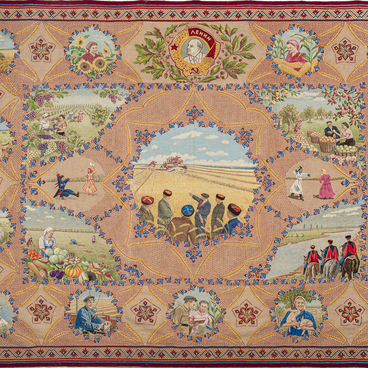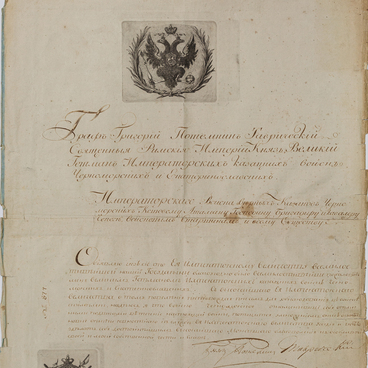A piece of authentic Nottingham lace is housed in the Krasnodar State Historical and Archaeological Museum named after E. D. Felitsyn. It was made in 2016 in the partner city of Krasnodar — Nottingham in Great Britain, which has been famous for lace production for several centuries.
The lace is made in the Cluny technique, which appeared in the 19th century in France. The old guipure, which was in fashion since the 16th century, served as a basis for it. French craftswomen created lace by hand on bobbins, and machine lacing in the same style was introduced in England. In addition to Cluny lace, Nottingham made products in the filet technique: their pattern consisted of a knitted net with identical rectangular cells.
The basis of the lace consists of the so-called ‘web’ — intertwined threads that gather all the elements into a whole. The pattern consists of regular petals, which touch each other at their ends. The pattern consists of solid, irregular, and twisted links. The edge of the piece is trimmed with small arc-shaped elements. In the upper left corner, there is a label with the inscription ‘Debbie Bryan Made in the UK’.
This lace was made by the Nottingham firm ‘Debbie Bryan’. The company has been supplying machine lace to the Royal School of Needlework in Hampton Court since 2012. The wedding dress of Kate Middleton, the Duchess of Cambridge, the wife of the British Prince William, was decorated with the lace produced by ‘Debbie Bryan’. This company is managed by the ninth generation of the Bryan family.
The Krasnodar State Historical and Archaeological Museum named after E. D. Felitsyn displays the lace together with an annotation in English. It begins with the words, ‘This piece of original Nottingham lace was presented as a sign of friendship from Nottingham to its sister-city Krasnodar…’ Then there follows a detailed description of how the lace has been produced.
Olesya Chalaya, the main specialist of the department of foreign relations of Krasnodar city Administration, has given the piece of lace to the collection of the Krasnodar State Historical and Architectural Museum named after Felitsyn.
The lace is made in the Cluny technique, which appeared in the 19th century in France. The old guipure, which was in fashion since the 16th century, served as a basis for it. French craftswomen created lace by hand on bobbins, and machine lacing in the same style was introduced in England. In addition to Cluny lace, Nottingham made products in the filet technique: their pattern consisted of a knitted net with identical rectangular cells.
The basis of the lace consists of the so-called ‘web’ — intertwined threads that gather all the elements into a whole. The pattern consists of regular petals, which touch each other at their ends. The pattern consists of solid, irregular, and twisted links. The edge of the piece is trimmed with small arc-shaped elements. In the upper left corner, there is a label with the inscription ‘Debbie Bryan Made in the UK’.
This lace was made by the Nottingham firm ‘Debbie Bryan’. The company has been supplying machine lace to the Royal School of Needlework in Hampton Court since 2012. The wedding dress of Kate Middleton, the Duchess of Cambridge, the wife of the British Prince William, was decorated with the lace produced by ‘Debbie Bryan’. This company is managed by the ninth generation of the Bryan family.
The Krasnodar State Historical and Archaeological Museum named after E. D. Felitsyn displays the lace together with an annotation in English. It begins with the words, ‘This piece of original Nottingham lace was presented as a sign of friendship from Nottingham to its sister-city Krasnodar…’ Then there follows a detailed description of how the lace has been produced.
Olesya Chalaya, the main specialist of the department of foreign relations of Krasnodar city Administration, has given the piece of lace to the collection of the Krasnodar State Historical and Architectural Museum named after Felitsyn.



